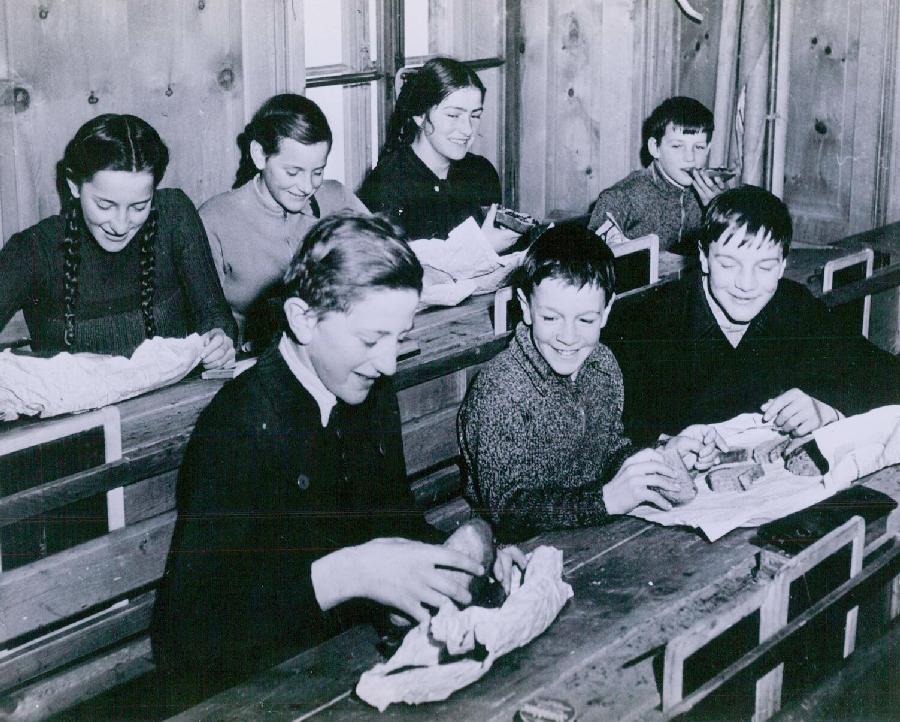
Swiss School Activities: The Classroom

Figure 1.-- Here we see Swiss children in Avers, a small village, at their classroom benches. Notice all the slate boards. This is what the Swiss classroom looked like for a century and did not begin to change until after World War II. This photograph is not dated, but we would guess was taken about 1950s, just as the Swiss classroom was beginning to change. These children lived at some distance from the school and rather than going home for lunch, brought their lunch and ate it in the classroom. The press caption read, "Avers in the Grisons, Switzerland, has an altitude of 6400 feet a/s. It is the highest village in Europe, inhabited throughout the year. Located on the Avers branch of the river Rhine the tiny settlement, although near to Italian speaking sectiions, uses the German language. The seven children of Avers, togeher with ten pupils from the environs, are taughr first to eighth grade work inclusive in one general school-room. The teacher, Mr. Peiti, is also Mayor of Avers . This phitograph shows children coming from a distance enjoying the lunch they brought along."
|
|
Classroom activities are fairly standard. The activity program at Swiss schools tended to be somewhat different than in America. Swiss and other Europan schools had a more academic orientation than in America. Not that it was all academics, but the extra-curricular activity program was much more limited. We see fairly standard classroom arrangements through the World War II era, meaning banks of benches which left little room of movement. The children all faced the teacher at his or her desk or at the black board. Chalk and slate boards were the limits of technology. The children were set in place to mlisten to the teacher and work with slate boards and class note books. Recitations were important. There was little group activity. And indows and light were limited. We see this begin to change after the revovery from the War. (Switzerland managed to stay out of gthe War, but was the economy was badly affected by the War.) We see the class rooms opening up with more windows and light. And we see the old school benches which served for a century being done away with and the children provided with individual desks. We see far less emphasis on recitations. Even though Swiss clss rooms today are very different than pre-War classrooms, we note reports of poor air quality. ["Poor ...."] The greatest change in the Swiss classroom has not just been opening it up but the adoption of tcvhnomlgy, namely calculatirs and computers. Swiss educators are now debating just how much technology is beneficial in the classroom. [Leybold-Johnson]
Sources
Leybold-Johnson, Isobel. "How much tech should be in Swiss classrooms?" SWI (November 29, 2018).
"Poor air quality in two thirds of Swiss classrooms," Le News (May 3, 2019).
HBC-SU

Related Chronolgy Pages in the Boys' Historical Web Site
[Main Chronology Page]
[The 1900s]
[The 1910s]
[The 1920s]
[The 1930s]
[The 1940s]
[The 1950s]
[The 1960s]
[The 1970s]
Navigate the Relate Boys Historical Clothing Style Pages
[Main country page]
[Long pants suits]
[Short pants suits]
[Lederhosen]
[Kneesocks]
[Eton suits]
[Jacket and trousers]
[Smocks]
[Blazer
[School sandals]
Navigate the Boys' Historical Clothing School Pages
[Return to the Main Swiss School Page]
[Return to the Main National School Uniform Page]
[Australia]
[England]
[France]
[Germany]
[Ireland]
[Italy]
[Japan]
[New Zealand]
[The Philippines]
[Poland]
[Scotland]
[South Africa]
[United States]
Navigate the HBC Shool Section
[Return to the Main Swiss school activity page]
[About Us]
[Activities]
[Chronology]
[Clothing styles]
[Countries]
[Debate]
[Economics]
[Garment]
[Gender]
[Hair]
[History]
[Home trends]
[Literary characters]
[School types]
[Significance]
[Transport and travel
[Uniform regulations]
[Year level]
[Other topics]
[Images]
[Links]
[Registration]
[Tools]
[Return to the Historic Boys' School Home]
Last updated: 7:10 PM 7/15/2019




